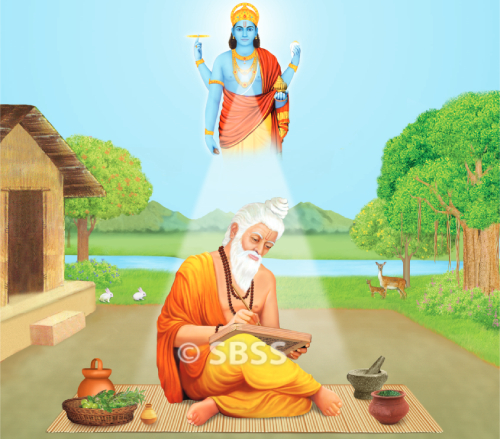Srotodushti (Vitiation of Body Channels) – Infectious Diseases and Parasitic Infestations
Ayurveda for a healthy life ! – 32/2024 on 16. 7.2024

Krumiroga
(Infectious Diseases and Parasitic Infestations)
Our Saints and Sages have conducted detailed studies on disease-causing germs thousands of years ago. The germs play a very important role in pathogenesis of a disease.
Germs and parasites are of two types : external and internal.
1. Bahyakrumi that is external germs and parasites
तेषां समुत्थानं मृजावर्जनम् । – च. वि.७
Unclean habits promote the growth of these germs and parasites.
अणवस्तिलाकृतयो बहुपादाश्च वर्णः कृष्णः शुक्लश्च ।। – च. वि. ७
They are minute, invisible or microscopic in size. They are white or black in colour. Yooka that is lice and Pipeelika that is ant-like parasites of scabies and other microscopic krumis affect hair and skin.
2. Abhyantara that is internal germs and parasites
They are divided into – A. Raktaja krumi that is germs and parasites in blood B. Shleshmaja krumi that is germs and parasites in the region where kapha dominates and C. Pureeshaja krumi that is germs and parasites in faeces.
A. Raktaja Krumi : These germs and parasites are termed as – 1. Keshada that is those eating hair, 2. Lomada that is thriving on body hair, 3. Nakhada that is thriving on nails 4. Dantada that is thriving on teeth and which leads to caries of teeth, 5. Kikkisa, 6. Kushtaja, 7. Parisarpa, 8. Lomadwipa, 9. Sourasa, 10. Oudumbara and 11. Jantumatru, causing various skin diseases. These parasites are very minute and round in shape. They are present in the blood. The factors leading to skin diseases promote the growth of these parasites.
B. Shleshmaja or kaphaja krumi that is parasites thriving on kapha. The growth of these parasites is promoted by taking in excess milk, jaggery, til, pulses, udid, leafy vegetables, meat of the aquatic animals, sweets, curds, oil, starchy food, sunflower oil; in digested, stale, rotten and dirty food and incompatible diet. These parasites initially arise in stomach and later can affect the areas where kapha dominates. They are white or red in colour, flat, round or elongated in shape and minute or microscopic in size. Their names are Antrada that is thriving on small intestine; Udarada that is thriving in abdomen; Hrudayachara that is thriving on heart; Darbhapushpi that is having a big anus; Praloona that is rounded chipita, flat Pipeelika that is resembling an ant and Daruna that is those leading to severe sickness. These germs & parasites affect brain, eyes, palate, ears and give rise to headache, unconsciousness, anorexia, indigestion, fever, fainting, yawning, sneezing, colds, vomiting, distension, loss of weight and stiffness of the body.
Treatment
The treatment consists of 1. Administration of medicines, which will act on the causative germs or parasites. The diet and medicines should be dominant in bitter, pungent, astringent and hot qualities. 2. Apakarshana that is expulsion of worms by administration of milk, curds, jaggery, til, fish, meat of aquatic animals, starchy food, etc. in the dinner. These dietetic factors attract the germs and parasites and thus the hold of the worms on the intestine is loosened. This is followed by administration of emetics, purgatives and enema next morning. Local cleansing medications should be administered to get rid off local germs and parasites, example cleansing nasal medication and cleansing eye-wash. 3. Prevention of recurrence by avoiding the aetiological factors.
Medical Treatment
1. Fresh juice or paste of palashabeeja should be taken with rice-water. 2. Fresh juice of leaves of paribhadraka, that is parwatanimba, should be taken with honey. 3. Fresh juice of pattura or surasadi group of medicines should be taken with honey. 4. Vidanga should be given by mouth.
Tilvaka, Karanja, Mustard, Koshataki, Shyama, Chavya, Chitraka, Bhrungaraja, Kadamba, Surasa, Pudina, Apamarga, Kutaja, Bakula, Swarnakshiri, Mushkaparni, Pippali, Kushtha, Kutaki, Ginger, Daruharidra, Kulattha kshara and Yavakshara also act on germs and parasites. For the treatment of Raktaja krumi, that is germs and parasites in the blood, you may refer to the chapter on treatment of skin diseases in the Ayurvedic texts.
C. Pureeshaja krumi that is parasites in faeces. The causative factors are the same as for kaphaja parasites. These germs and parasites are present in small and large intestines, and vary in size from minute to macroscopic. They may be flat, round or cylindrical. The colour may be black, blue, green or yellow. Their names are Gandupada that is round worms, Ajava that is worms with slow movement, Vijava that is with fast movement, Kipya, Chipya, Churu, Dwimukha, Kakeruka, Makeruka, Lehika that is those which lick the intestines, Shoolaka that is worms giving
rise to pain and Sousurada.
पुरीषभेदः कार्श्यपारुष्यं लोमहर्षाभिनिर्वर्तनं च त एव चास्य
गुदमुखं परितुदन्तः कण्डूं चोपजनयन्तो गुदमुखं पर्यासते त एव जातहर्षा गुदनिष्क्रमणमतिवेलं कुर्वन्ति । – च. वि. ७.१३
These parasites and germs give rise to diarrhoea, emaciation, goose-skin, itching of the anus, fever, anaemia, pain in the abdomen, giddiness, anorexia, heart diseases and weakness.